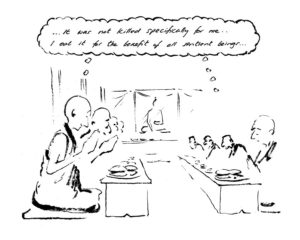Definition of the Week (5) – Negation
Negation according to the first Dalai Lama Gyalwa Gedun Drub:
That which is realised through direct elimination of its object of negation.
Division: Affirming and non-affirming negation
Non-affirming negation: That which is realised through direct elimination of its object of negation and which doesn’t project another phenomena in place of the object of negation.
E.g., emptiness.
Emptiness has to be the mere negation of inherent existence, because in the non-dual meditative equipoise no illusory conventional phenomenon can appear.
From the Debate between Wisdom and Ignorance by Panchen Chokyi Gyaltsen, Ignorance says to Wisdom:
Focusing on the aggregates one says ‘I’.
Make the mere non-affirming negation [149]
Of true existence of this the object of apprehension.
If then, without weakening strength, but with clear intensity,
Free from mental sinking, excitement and apprehending characteristics,
One is skillful in training in the mode of apprehending, [150]
Where, upon having focused on the aggregates,
My non-existence appears as object,
Then this is is the mode of apprehending antithetical to me.
Then one is able to evict me. [151]
However, this is like a mere daytime star.
Choden Rinpoche, commenting on these lines:
One thinks ‘I’ in dependence on focusing on the aggregates. One eliminates this mode of apprehension in relation to the aggregates, refuting truly existent aggregates, and then one holds that mode of apprehension, the mere lack of true existence, without adding anything. The apprehended object is the mere lack of true existence and one has realized emptiness.
This is then combined with calm abiding, which is free from mental sinking or excitement and endowed with clear intensity. If one finds a person that is skilled in this way, this person can harm true-grasping and can evict true-grasping. But such a person is as rare as a star in daylight.


